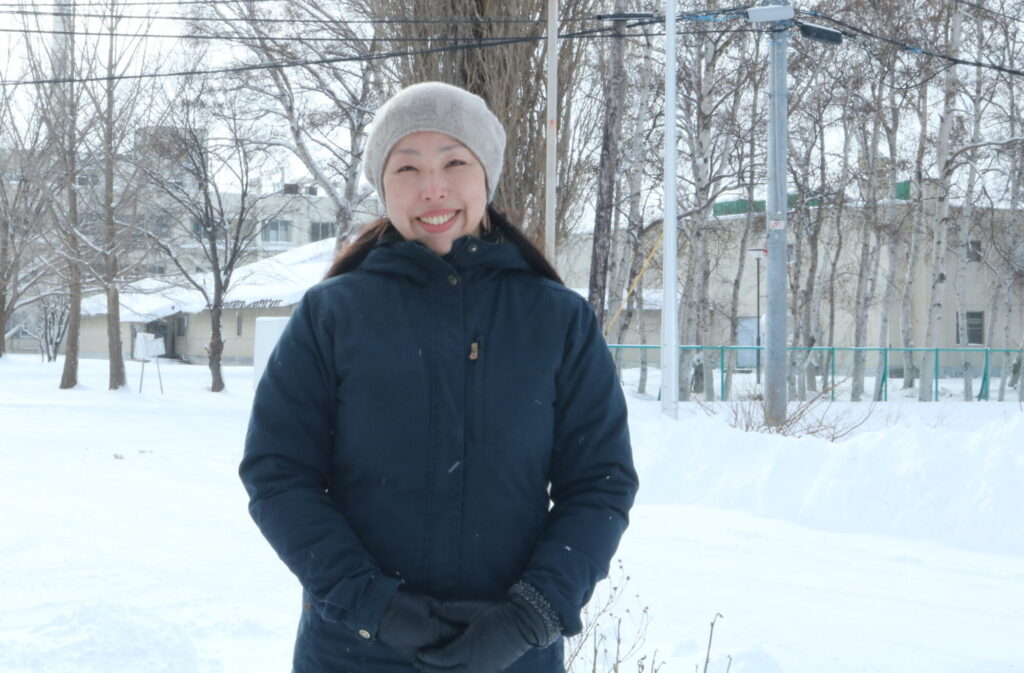
Ainu Advocacy Shines Through Academia and Arts
Assistant Professor Kanako Uzawa (Global Station for Indigenous Studies and Cultural Diversity, GSI – Global Institution for Collaborative Research and Education, GI-CoRE) is an Ainu scholar and artist whose research primarily links the world of art with scholarly advocacy. Through her works, she amplifies the often-unheard voices of Japan’s native Ainu people and challenges conventional views on art.
Uzawa’s maternal grandfather, Tadashi Kaizawa, was a prominent figure within the Ainu community in Nibutani. Growing up, she learned about indigenous rights by witnessing the intense struggle between the Ainu people of Nibutani and the Japanese government in a case often referred to as the Nibutani Dam Case. This case centered on the governmental plan to construct a dam in an area that the Ainu considered to be a violation of indigenous rights.
“Because of the intensifying discussion on the Nibutani Dam Case, I became more interested in Ainu-related issues and identity, especially since my teenage years,” said Uzawa, recalling the early period of her life which led to her path as a scholar in indigenous studies.
“For me, I created art as my interpretation of Ainupuri, ‘the Ainu way of life.’ I interpreted this concept as something that differs individually,” said Uzawa, who found that art can act as an intergenerational bridge. “Art is also a valuable tool for connecting the elders with the youths. For instance, the difficult topic of the repatriation of human remains is very well-known among the indigenous elders, but it may be less discussed among the younger generations.”
As a researcher, Uzawa is challenging the conventional notions of art: What do people consider to be art? Could there be a different way of looking at art?
“I wanted to address those points because art is generally considered to be something sophisticated by most people-but who gets to decide what counts as art, and whether it should be seen that way, is a question in itself.. And, generally speaking, Ainu culture doesn’t create artworks that are purely decorative. Ainu objects that are commonly sold in tourist shops, such as trays, are inherently everyday items. So, I began to wonder what art is.”
Uzawa continued, “For me, art should be accessible. This discussion is what I’m bringing forward through my curatorial works.”
In her efforts of challenging the conventional definition of art, Uzawa has been introducing living, contemporary Ainu artists in her curatorial works. According to Uzawa, engaging with artworks by indigenous artists, whether as purchasable goods or as displays in galleries, should be critical.
“I believe the best practice in showcasing indigenous artists’ work is by honoring their wishes. The artists should have full control of the production and sale of their pieces. For exhibitions, ideally, the art should tell more than just the artist’s name and the year-it should also convey the story behind the creation of the piece.”
One of Uzawa’s ongoing projects is curating an upcoming exhibition scheduled for September 2026 at the University of Michigan Museum of Art. By visiting several museums across the United States, Uzawa collects and documents information on historical objects that were part of colonial practices. The documentation is presented to contemporary indigenous artists in Japan with the hope that they would draw inspiration from them and produce new works of art for the exhibition.
Similarly, Uzawa is also curating for a section on Ainu contemporary art in an upcoming exhibition organized by the National Museum of Lithuania. The exhibition will focus on the 160th anniversary of Bronisław Piłsudski, a renowned Polish-born ethnologist who was exiled to Sakhalin and conducted extensive research on the Ainu people.
It is not an overexaggeration to say that international networking is gearing Uzawa’s academic and artistic endeavors.
“My workplace is this entire planet,” Uzawa jokes, followed by a laugh. “Through my various encounters with indigenous peoples, indigenous studies researchers, and artists worldwide, I found that all indigenous groups share at least one commonality: we are underrepresented. Because of this lack of voice, I created AinuToday.”
Launched in 2021, AinuToday offers resources in Japanese and English related to Ainu, organized into three main categories: Academia, Advocacy, and Art. Academia is a collection of academic publications (journals, articles), including some of Uzawa’s own work. Advocacy highlights ongoing discussions surrounding Ainu, focusing on current events. In Art, visitors can explore artistic works by various Ainu artists.
She also shared that through this freely accessible platform, she would like to show the world what it is like to roam the world as an Ainu person in the 21st century. “I hope to change and move beyond the stereotypes of Ainu people: bears, living in nature, wearing only traditional clothes, etc.”
Alongside her curatorial and other projects, AinuToday is an all-inclusive initiative aimed at deepening the public’s interest and understanding of Ainu-related topics more critically. Uzawa, however, places particular emphasis on engaging younger audiences.
“I am bridging the academia and art because I hope to inspire people, especially the youths, indigenous youths included. The general population in Japan is decreasing, and so is the Indigenous people. My hope is that more young people will follow suit and create their own art and tell their own unique stories,” said Uzawa.
Written by Aprilia Agatha Gunawan
https://www.global.hokudai.ac.jp/blog/spotlight-on-research-advocating-ainu-through-academia-and-arts/

